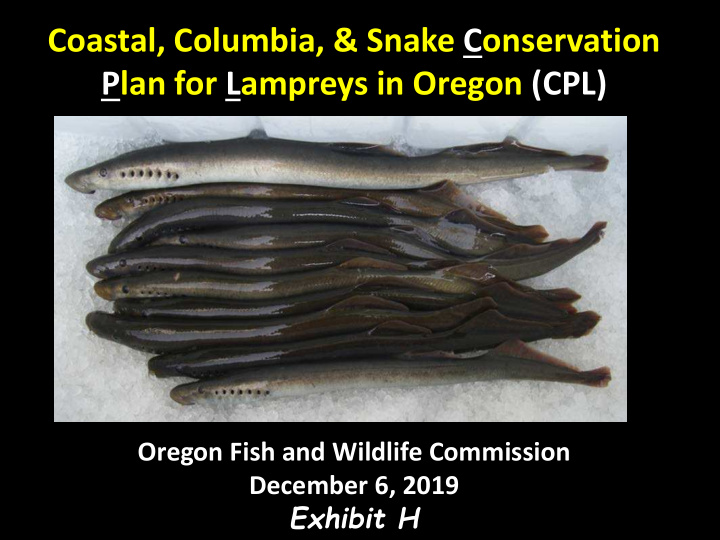



Coastal, Columbia, & Snake Conservation Plan for Lampreys in Oregon (CPL) Oregon Fish and Wildlife Commission December 6, 2019 Exhibit H
• Context & species • Process • Overview of CPL • New rule • Recommendation
Context & species • Native Fish Conservation Policy (2002) – OAR 635-007-0502 through 0509 – Naturally-produced fish foundational for conservation and opportunity – Implemented through Conservation Plans • Miller Lake Lamprey – 2005 • 16 C&R plans for 33 SMUs
Context & species • Supports efforts for Pacific Lamprey by – Tribes – U.S. Fish & Wildlife Service – Others • Covers 3 other lamprey species
Anadromous & parasitic Pacific Lamprey (13-33”) Western River Lamprey (4-12”) Resident & non-feeding Western Brook Lamprey (3-7”) Pacific Brook Lamprey (4-7”) Emanuela D’Antoni in Renaud (2011)
8
Ecosystem integrators 41 predators 32 prey 9
Process • Internal development • External development – Tribes, tribal agencies – U.S. Fish & Wildlife Service – Others biologists, managers, conservationists • Science review • Public comment – Website – Written comment period – Public meetings • Commission review
Overview of CPL Miller Lake Lamprey Conservation Plan Draft Klamath Reintroduction Plan
Western River Lamprey Western Brook Lamprey Pacific Brook Lamprey
Current status • Sufficient data o Pacific Lamprey Distribution Adult abundance trends Connectivity • Insufficient data o Western River Lamprey o Western Brook Lamprey o Pacific Brook Lamprey
Willamette Falls 1913 14 Source: Clackamas County Historical Society
No. of adult Pacific Lamprey No counts Bonneville Dam
Bonneville Dam 16
Pacific Lamprey Population Strata Current Status Desired Status Rogue/South Coast Common Prevalent Coastal Prevalent Prevalent Lower Columbia Common Prevalent Willamette Common Prevalent Mid Columbia Limited Common Lower Snake Rare Common Upper Snake Absent Common Sensitive Strong-Guarded Species Management Unit
Western River Lamprey, Western Brook Lamprey, Pacific Brook Lamprey Current Status Desired Status Population Strata Common Undetermined Species Management Unit Sensitive Strong-Guarded
Anadromous & parasitic Pacific Lamprey (13-33”) Western River Lamprey (4-12”) Resident & non-feeding Western Brook Lamprey (3-7”) Pacific Brook Lamprey (4-7”) Emanuela D’Antoni in Renaud (2011)
Key Limiting Factors 1) Access (passage & screening) 2) Water quantity (reduced flows & flow mgmt) 3) Water quality (high water temp & sedimentation) 4) Physical habitat (stream & floodplain degradation) 5) Predation by other species (non-native fishes) 20
Future threats • Climate change • Estuary & ocean conditions • Development (human population growth) 21
Management strategies 1. Education & outreach (New) 2. Passage & screening (New & Existing) 3. Protect & restore habitat (Existing) 4. Water conservation (Existing) 5. Translocation (New) 6. Establish in-water work BMPs (New) 7. Modify angling regulations on non-native fishes (New & Existing) 8. Pinniped mgmt (Existing) 22
Research, Monitoring, & Evaluation 1. Improve distribution data (New & Existing) 2. Prioritize artificial obstructions for passage & screening (New) 3. Inform passage & screening (New) 4. Improve biological knowledge (New) 5. Estimate take (New & Existing) 6. Assess complex, large-scale threats (New) 7. Assess translocation (New) 8. Estimate adult abundance (New & Existing) 9. Monitor diversity (New) 23
Implementation • Complements work by partners • Collaborative approach • Timeline & cost – No new $ – Leverage existing work – Grants for particular projects • Adaptive management 24
OAR 635-500-6780 ( New Rule ) • Same approach as other plans • Codifies all elements required by NFCP
Recommendation “I move to approve the Coastal, Columbia, and Snake Conservation Plan for Lampreys in Oregon, and adopt the associated proposed Oregon Administrative Rule set forth in Attachment 3.”
Recommend
More recommend